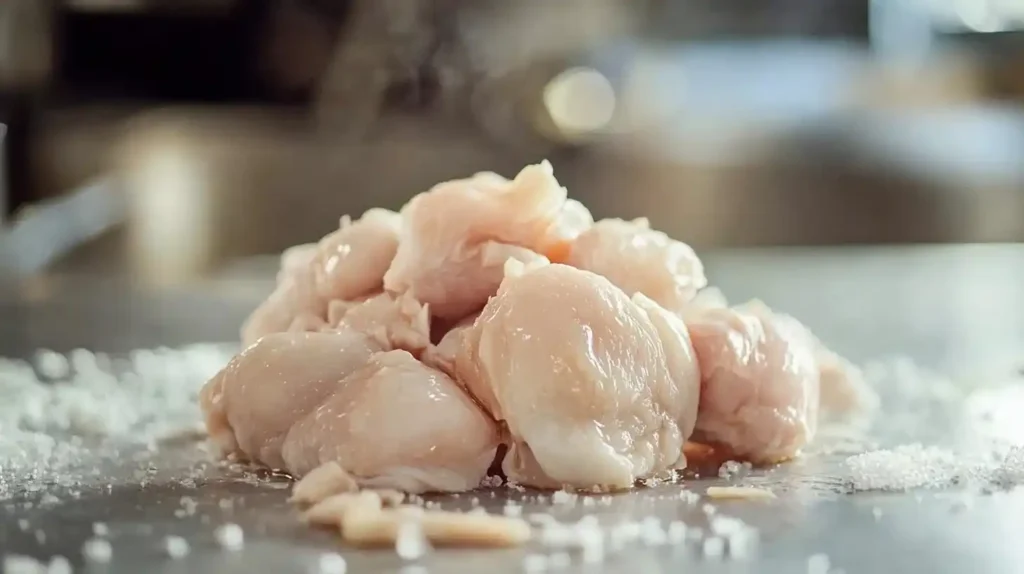How to Make Chicken Not Chewy and Tender?
Chicken is a staple in kitchens worldwide, celebrated for its versatility and flavor. However, achieving perfectly tender and juicy chicken can be a challenge, leaving many cooks asking the question: How to make chicken not chewy and tender? Whether you’re a seasoned chef or a home cook, dealing with dry, rubbery chicken can be frustrating and often ruins a dish.
The good news is that with the right techniques and understanding of chicken preparation, you can consistently cook moist, flavorful, and tender chicken every time. This guide will explore the reasons chicken turns tough, the best preparation methods like marination and brining, and the cooking techniques that lock in moisture. By mastering these steps, you’ll never have to settle for chewy chicken again. Let’s uncover the secrets to perfectly cooked chicken!
Why Chicken Turns Chewy and Tough
Chicken can become chewy and tough for several reasons, many of which are easy to overlook but crucial to the cooking process. Understanding these common pitfalls is the first step to achieving tender, juicy chicken.
1. Overcooking or Undercooking
One of the most common mistakes is overcooking chicken. When exposed to high heat for too long, chicken loses its natural juices, resulting in a dry, rubbery texture. Conversely, undercooked chicken can have a chewy, unpleasant consistency, as the proteins haven’t had enough time to break down properly.
2. Poor Quality or Improperly Handled Chicken
The quality of the chicken plays a major role in its texture. Low-grade chicken or meat that has been frozen and thawed multiple times often lacks the moisture and structure needed to stay tender. Improper storage can also degrade the meat, making it less likely to cook well.
3. Skipping Preparation Steps
Failing to marinate or brine your chicken can leave it tough and flavorless. These preparation steps help break down proteins, infuse flavor, and add moisture, all of which contribute to a tender texture.
By addressing these issues, you can significantly improve your cooking outcomes and avoid the common problem of chewy chicken. Proper preparation and attention to detail are the keys to success!
Types of Chicken Cuts and Their Impact on Texture

Choosing the right chicken cut is essential to achieving tender, juicy results. Different cuts have varying fat content, connective tissues, and cooking requirements, all of which affect texture. Here’s a breakdown of popular cuts and their impact on tenderness:
1. Chicken Breasts
Chicken breasts are lean and quick-cooking, but they dry out easily if overcooked, leading to a chewy or rubbery texture. They are best suited for marination or brining to retain moisture during cooking.
2. Chicken Thighs
Thighs are fattier and more forgiving than breasts, making them naturally juicy and tender. They are ideal for slow-cooking methods like braising or stewing, as the fat keeps them moist.
3. Drumsticks and Wings
These cuts contain more connective tissue, which breaks down during long, slow cooking processes. This makes them excellent for roasting, grilling, or braising, resulting in rich, flavorful meat.
Understanding the unique characteristics of each cut helps you choose the right preparation and cooking method, ensuring tender chicken every time. Matching the cut to the recipe is a critical step in avoiding tough, dry chicken.
Frequently Asked Questions (FAQs)
1. Why is my chicken rubbery after cooking?
Rubbery chicken is often caused by overcooking. When chicken is cooked too long at high heat, it loses its natural moisture, resulting in a tough texture. Using a meat thermometer can help you avoid this by ensuring you remove the chicken as soon as it reaches the proper internal temperature of 165°F (74°C).
2. How long should I marinate chicken?
The marination time depends on the cut and the marinade ingredients:
- For boneless chicken breasts, marinate for 2–4 hours.
- Bone-in cuts like thighs and drumsticks can marinate for up to 12–24 hours.
- Avoid marinating for too long with acidic marinades (like lemon or vinegar), as they can break down the meat excessively, making it mushy.
3. Is it better to cook chicken with the skin on?
Cooking chicken with the skin on helps retain moisture and adds flavor. The skin acts as a barrier, keeping the meat juicy and protecting it from overcooking. You can always remove the skin after cooking if you prefer a leaner option.
4. What is the ideal internal temperature for chicken?
The USDA recommends cooking chicken to an internal temperature of 165°F (74°C) for safe consumption. For dark meat like thighs and drumsticks, you can cook it slightly higher (175–190°F) for extra tenderness and flavor.
5. Can I brine chicken overnight?
Yes, brining chicken overnight is ideal for larger cuts like whole chickens. However, limit the brine time to 12–24 hours to avoid overly salty or mushy meat. Be sure to rinse and pat dry the chicken before cooking.
These FAQs address common concerns about cooking chicken, ensuring you can consistently achieve tender, juicy results every time!

Advanced Tips
Avoid Common Mistakes
Cooking chicken to perfection requires attention to detail, and avoiding common pitfalls can make all the difference in achieving tender, juicy results. Here are the most frequent mistakes and how to steer clear of them:
1. Skipping Marination or Brining
Preparation is key to tender chicken. Failing to marinate or brine leaves the meat vulnerable to drying out during cooking. These steps not only add moisture but also enhance flavor, making them essential for delicious results.
2. Overcooking
Overcooking is one of the main reasons chicken becomes rubbery and tough. Always monitor cooking time closely, especially for lean cuts like chicken breasts. Use a meat thermometer to ensure the internal temperature reaches 165°F (74°C) and no more.
3. Undercooking
Undercooking chicken leaves it chewy and potentially unsafe to eat. Verify doneness with a thermometer, and always check thicker cuts to ensure they’re fully cooked.
4. Overcrowding the Pan
When cooking chicken in a skillet or baking dish, ensure there’s enough space between pieces. Overcrowding creates steam, preventing proper browning and resulting in uneven cooking.
5. Skipping the Resting Period
After cooking, allow the chicken to rest for 5–10 minutes. This step redistributes juices, ensuring the meat stays moist when sliced.
By avoiding these common mistakes, you can consistently achieve tender, flavorful chicken every time. Simple adjustments in preparation and cooking techniques can make a significant difference!
Choosing the Right Equipment
The right kitchen tools can greatly impact how tender and flavorful your chicken turns out. From preparation to cooking, having the proper equipment ensures consistent and delicious results.
Must-Have Tools
- Meat Thermometer: A meat thermometer is essential to check the internal temperature of chicken, ensuring it’s cooked to the safe level of 165°F (74°C) without overcooking.
- Cast-Iron Skillet: Ideal for searing chicken, a cast-iron skillet provides even heat distribution for a golden-brown crust.
- Slow Cooker or Instant Pot: These appliances are perfect for low-and-slow cooking methods, like braising, that break down connective tissues and keep chicken tender.
Additional Recommendations
- Sharp Knives: For clean, even cuts that promote uniform cooking.
- Sous-Vide Machine: Precision cooking that guarantees perfectly tender chicken every time.
- Cutting Board with Grooves: Prevents juices from spilling when slicing cooked chicken.
By using the right equipment, you’ll not only improve your cooking process but also elevate the texture and flavor of your chicken dishes, ensuring consistently excellent results.
Explore more recipes similair:
- Opportunity
- “Tips for perfectly seasoned chicken” linking to What Is Harissa Made Of Chicken?
- “How to fix tough chicken” linking to Why Is My Braised Chicken Tough?
- “Cooking techniques for juicy chicken” linking to What Does Braising Do To Chicken?

